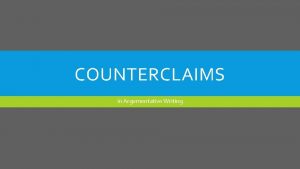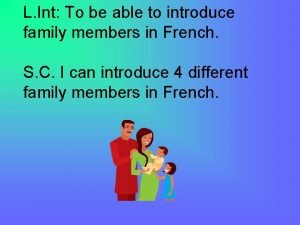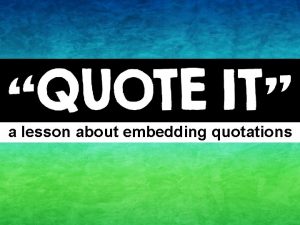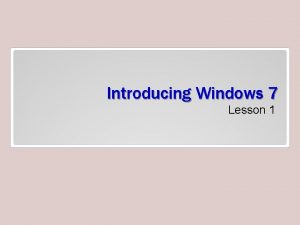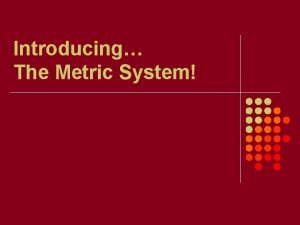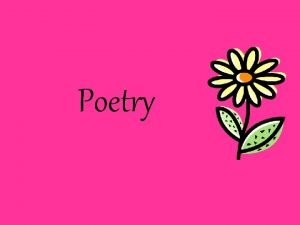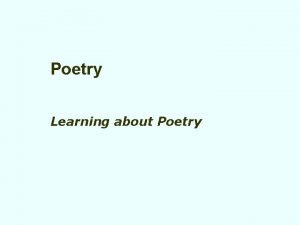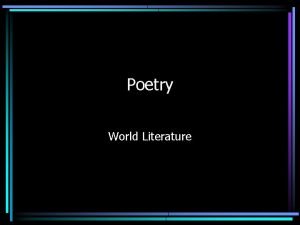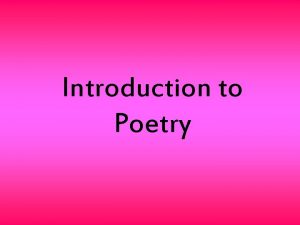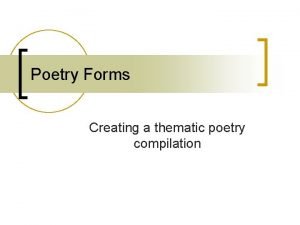Welcome to my favorite unit introducing POETRY What



















- Slides: 19

Welcome to my favorite unit! introducing POETRY

What do you need to know about poetry? 1 2 3 The Structure of a Poem Types of Poetry Famous Poets

1 THE STRUCTURE OF A POEM

What are the building blocks of poetry? Epetition The act of repeating Building Blocks Hyme To repeat sounds Hyme scheme The rhyming pattern in a poem To find the rhyme scheme, look at the last word in each line. *Examples - AABB Computers are fun. I gave one to my son. He is very nice, and I was happy with the price. a a b b

Your Turn Packet Page 1 Click on the links below, and read the poems. Then, write the title of each poem and its rhyme scheme. You do not have to write the entire poem. Only write the title of the poem and the rhyme scheme. http: //www. kidskorner. net/rhymes/realwinner. html http: //www. kidskorner. net/rhymes/wormpie. html

Your Turn Packet Page 2 Complete the short poem. The poem must follow the rhyme scheme: AABBCC

What are the building blocks of poetry? Building Blocks Ssonance The repetition of vowel sounds *Examples: The ball went into the wall. The phone was in the cone. Lliteration The repetition of consonant sounds *Examples – safe and sound fish and fowl rhyme and reason Efrain To repeat one or more phrases or lines in a poem *The refrain usually occurs at the end of each stanza.

Your Turn Packet Page 3 1. Listen to “Clooney the Clown” https: //vimeo. com/51028948 2. Re-read the poem, Cloony the Clown and complete the following. Be sure to write the entire line. http: //famouspoetsandpoems. com/poets/shel_silverstein/poems/14822 • Write 3 lines that use alliteration. • Write 2 lines that contain assonance. • What line is repeated in the poem (refrain)?

2 TYPES OF POEMS

What are the building blocks of poetry? Tanza - A group of lines within a poem The lines of a stanza often have a particular rhyme scheme. Building Blocks uatrain A poem or stanza that has four lines. ouplet A couplet is the basic form of poetry. Think about the word “couple” when you think of a couplet. A couplet is composed of two lines of poetry that rhyme.

Limerick A limerick is a five-line poem with the rhyme scheme AABBA. *Limericks are meant to be funny. They often contain hyperboles, onomatopoeia, and other forms of figurative language.

Limericks. 1. Click on the following link to read a few limericks. http: //www. brownielocks. com/kidlimericks. html : 2. View the limerick video. 3. Complete the activity on packet page 4.

Haiku What is a haiku? Click the following link to find out. https: //www. youtube. com/watch? v= g. OMu. Vp. N 8 Xq. M http: //www. poetry 4 kids. com/blog/le ssons/how-to-write-a-haiku/ *Remember, the first line has five syllables, the second line has seven syllables, and the third line has five syllables.

Haiku Your Turn • Write YOUR OWN HAIKU using page 5 of your poetry packet. • Be sure to follow the correct syllable format. • Many haikus describe something in nature, but you can be creative as you’d like!

Record the information and complete page 6!

3 FAMOUS POETS

Edgar Allan Poe was born on January 19, 1809, in Boston, Massachusetts. He is best known for horror stories. His most famous works include The Tell-Tale Heart and The Raven. Your Turn Answer the following questions on page 7 of your poetry packet. A Dream In visions of the dark night I have dreamed of joy departed; But a waking dream of life and light Hath left me broken-hearted. That holy dream, that holy dream, While all the world were chiding, Hath cheered me as a lovely beam, A lonely spirit guiding. Ah! what is not a dream by day To him whose eyes are cast On things around him, with a ray Turned back upon the past? What though that light, thro' storm and night, So trembled from afar-What could there be more purely bright In Truth's day-star? 1. Why is the poet broken-hearted? 2. What is the tone of the poem? 3. What is the rhyme scheme of the poem? 4. Give an example of the use of personification within the poem.

Shel Silverstein Birthdate: September 25, 1930 Date of Death: May 10, 1999 Birthplace: Chicago, Illinois *Shel Silverstein was a famous children’s poet. His famous works include The Giving Tree and Where the Sidewalk Ends. Your Turn Where the Sidewalk Ends from the book "Where the Sidewalk Ends" (1974) There is a place where the sidewalk ends and before the street begins, and there the grass grows soft and white, and there the sun burns crimson bright, and there the moon-bird rests from his flight to cool in the peppermint wind. Yes we'll walk with a walk that is measured and slow, and we'll go where the chalk-white arrows go, for the children, they mark, and the children, they know, the place where the sidewalk ends. Let us leave this place where the smoke blows black and the dark street winds and bends. Past the pits where the asphalt flowers grow we shall walk with a walk that is measured and slow and watch where the chalk-white arrows go to the place where the sidewalk ends. Answer the following questions on page 8 of your poetry packet. 1. What is the central idea of the poem? 2. What is the tone of the poem? 3. What is the rhyme scheme of the poem? 4. How many stanzas are there in this poem?

You’ve reached the end of our poetry unit. Please see me. What’s Your Message?
 Welcome welcome this is our christmas story
Welcome welcome this is our christmas story Unit 10, unit 10 review tests, unit 10 general test
Unit 10, unit 10 review tests, unit 10 general test What's a signal phrase
What's a signal phrase Introduction to english linguistics exercises answers
Introduction to english linguistics exercises answers Introducing james joyce
Introducing james joyce Introducing a quote sentence starters
Introducing a quote sentence starters What is a counterclaim in writing
What is a counterclaim in writing Introducing yourself for a job
Introducing yourself for a job Talk boost tracker
Talk boost tracker Ma
Ma Rondeau poem example
Rondeau poem example Introduction of digestive system
Introduction of digestive system Kfc gegründet
Kfc gegründet What are integers
What are integers Introducing internet
Introducing internet How to do quotes in mla format
How to do quotes in mla format New market offering
New market offering As he himself puts it the art of quoting summary
As he himself puts it the art of quoting summary Introducing windows 7
Introducing windows 7 Khdmdcm conversion
Khdmdcm conversion






